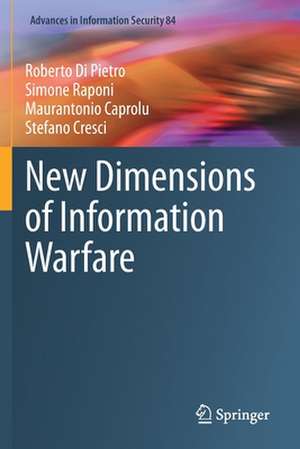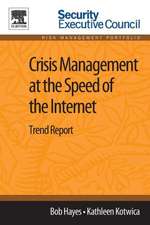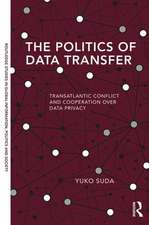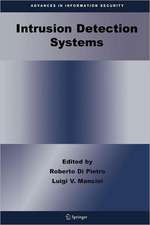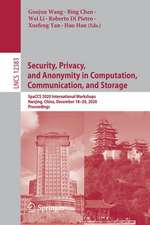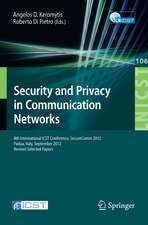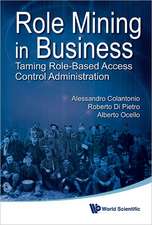New Dimensions of Information Warfare: Advances in Information Security, cartea 84
Autor Roberto Di Pietro, Simone Raponi, Maurantonio Caprolu, Stefano Crescien Limba Engleză Paperback – 5 dec 2021
This book revises the strategic objectives of Information Warfare, interpreting them according to the modern canons of information age, focusing on the fabric of society, the economy, and critical Infrastructures. The authors build plausible detailed real-world scenarios for each entity, showing the related possible threats from the Information Warfare point of view. In addition, the authors dive into the description of the still open problems, especially when it comes to critical infrastructures, and the countermeasures that can be implemented, possibly inspiring further research in the domain.
This book intends to provide a conceptual framework and a methodological guide, enriched with vivid and compelling use cases for the readers (e.g. technologists, academicians, military, government) interested in what Information Warfare really means, when its lenses are applied to current technology. Without sacrificing accuracy, rigor and, most importantly, the big picture of Information Warfare, this book dives into several relevant and up-to-date critical domains.
The authors illustrate how finance (an always green target of Information Warfare) is intertwined with Social Media, and how an opponent could exploit these latter ones to reach its objectives. Also, how cryptocurrencies are going to reshape the economy, and the risks involved by this paradigm shift. Even more compelling is how the very fabric of society is going to be reshaped by technology, for instance how our democratic elections are exposed to risks that are even greater than what appears in the current public discussions. Not to mention how our Critical Infrastructure is becoming exposed to a series of novel threats, ranging from state-supported malware to drones. A detailed discussion of possible countermeasures and what the open issues are for each of the highlighted threats complete this book.
This book targets a widespread audience that includes researchers and advanced level students studying and working in computer science with a focus on security. Military officers, government officials and professionals working in this field will also find this book useful as a reference.
| Toate formatele și edițiile | Preț | Express |
|---|---|---|
| Paperback (1) | 1042.61 lei 6-8 săpt. | |
| Springer International Publishing – 5 dec 2021 | 1042.61 lei 6-8 săpt. | |
| Hardback (1) | 1048.86 lei 6-8 săpt. | |
| Springer International Publishing – 4 dec 2020 | 1048.86 lei 6-8 săpt. |
Din seria Advances in Information Security
- 20%
 Preț: 997.96 lei
Preț: 997.96 lei - 20%
 Preț: 647.28 lei
Preț: 647.28 lei - 20%
 Preț: 901.82 lei
Preț: 901.82 lei - 20%
 Preț: 1165.69 lei
Preț: 1165.69 lei - 20%
 Preț: 866.27 lei
Preț: 866.27 lei - 20%
 Preț: 935.19 lei
Preț: 935.19 lei - 20%
 Preț: 638.69 lei
Preț: 638.69 lei - 15%
 Preț: 637.28 lei
Preț: 637.28 lei - 20%
 Preț: 647.79 lei
Preț: 647.79 lei - 20%
 Preț: 1152.15 lei
Preț: 1152.15 lei - 18%
 Preț: 1004.81 lei
Preț: 1004.81 lei - 20%
 Preț: 545.13 lei
Preț: 545.13 lei - 20%
 Preț: 1050.67 lei
Preț: 1050.67 lei - 18%
 Preț: 1674.82 lei
Preț: 1674.82 lei - 20%
 Preț: 933.57 lei
Preț: 933.57 lei - 20%
 Preț: 1171.94 lei
Preț: 1171.94 lei - 20%
 Preț: 931.51 lei
Preț: 931.51 lei - 18%
 Preț: 949.10 lei
Preț: 949.10 lei - 20%
 Preț: 995.75 lei
Preț: 995.75 lei - 20%
 Preț: 644.66 lei
Preț: 644.66 lei - 20%
 Preț: 643.30 lei
Preț: 643.30 lei - 15%
 Preț: 641.20 lei
Preț: 641.20 lei - 20%
 Preț: 647.61 lei
Preț: 647.61 lei - 20%
 Preț: 648.11 lei
Preț: 648.11 lei - 20%
 Preț: 652.54 lei
Preț: 652.54 lei - 20%
 Preț: 642.98 lei
Preț: 642.98 lei - 20%
 Preț: 640.35 lei
Preț: 640.35 lei - 15%
 Preț: 639.59 lei
Preț: 639.59 lei - 15%
 Preț: 637.46 lei
Preț: 637.46 lei - 20%
 Preț: 820.50 lei
Preț: 820.50 lei - 18%
 Preț: 1219.01 lei
Preț: 1219.01 lei - 15%
 Preț: 634.18 lei
Preț: 634.18 lei
Preț: 1042.61 lei
Preț vechi: 1303.26 lei
-20% Nou
Puncte Express: 1564
Preț estimativ în valută:
199.53€ • 207.54$ • 164.72£
199.53€ • 207.54$ • 164.72£
Carte tipărită la comandă
Livrare economică 14-28 aprilie
Preluare comenzi: 021 569.72.76
Specificații
ISBN-13: 9783030606206
ISBN-10: 3030606201
Ilustrații: XV, 251 p. 30 illus. in color.
Dimensiuni: 155 x 235 mm
Greutate: 0.38 kg
Ediția:1st ed. 2021
Editura: Springer International Publishing
Colecția Springer
Seria Advances in Information Security
Locul publicării:Cham, Switzerland
ISBN-10: 3030606201
Ilustrații: XV, 251 p. 30 illus. in color.
Dimensiuni: 155 x 235 mm
Greutate: 0.38 kg
Ediția:1st ed. 2021
Editura: Springer International Publishing
Colecția Springer
Seria Advances in Information Security
Locul publicării:Cham, Switzerland
Cuprins
Preface.- Acknowledgements.- Foreword.- Organization.- Book structure.- 1. Information Disorder.- The new social ecosystem.- Threat: disinformation campaign.- Attacks.- Vaccine hesitancy.- Immigration.- Climate change.- Public naivety.- Alleged political scandals.- Countermeasures.- Low-quality information.- Fake-news detection and removal.- Credibility.- Spreading truth.- Datasets.- Malicious actors.- Social bots.- Fake profiles.- Astroturf.- Spammers.- Sock puppets.- Political memes.- New directions.- Part.- Economy.- State-sponsored Cryptocurrency.- Threat: Collapse of the cryptocurrencies.- Attacks and countermeasures.- Hash Functions.- Open Issues.- Scenario 2: Trust in the Computational Power.- Threat: New Technologies.- Scenario 3: Infrastructure.- Attacks and Countermeasures.- Open Issues.- Towards a State-Sponsored Cryptocurrency.- Bitcoin Limitations.- Develop a State-Sponsored Cryptocurrency.- Scenario 1: Stock market forecasts.- Threat: Information-based manipulation.- A large attack surface.- Attacks and countermeasures.- Open issues and future directions.- Threat: Trade-based manipulation.- Attacks.- Countermeasures.- Open issues and future directions.- Threat: Algorithm-based manipulation.- Algorithms taking over.- Loose cannons on the automation deck.- Attacks.- Countermeasures.- Open issues and future directions.- Other countermeasures.- Threat: Technological bias, divide, and monopoly.- Attacks and countermeasures.- Open issues and future directions.- Scenario 3: Remote stock market.- Threat: Attacks against availability.- Attacks and countermeasures.- Threat: Work-from-home perils.- Attacks.- Countermeasures.- Open issues and future directions.- Scenario 4: Complex financial networks.- Threat: Systemic risk and cascading failures.- Measures of systemic risk.- Economics and finance approaches.- Network approaches.- Countermeasures.- Open issues and future directions. Part.- Infrastructure.- Critical Infrastructure.- Scenario: Cyber Warfare targeting Critical Infrastructures.- Threat: Malware.- Attacks and Countermeasures.- Open Issues and Future Directions.- Scenario: A new Cyber-Physical threat from the sky.- Threat: Drones.- Attacks and Countermeasures.- Open Issues and Future Directions.- Attacks and countermeasures.- Open issues and future directions.- Threat: outsourcing of security.- Attacks and countermeasures.- Trust in the cloud.- Security perimeter.- Confidentiality.- Integrity.- Availability.- Open issues and future directions.- Technical side
Notă biografică
Dr. Roberto Di Pietro, ACM Distinguished Scientist, is Full Professor in Cybersecurity at HBKU-CSE. Previously, he was in the capacity of Global Head Security Research at Nokia Bell Labs, Associate Professor (with tenure) of Computer Science at University of Padova, and Assistant Professor (with tenure) at University of Roma Tre. He began his career serving for 10+ years in the military---8 years as état-major senior military officer within the Italian Carabinieri Army. Overall, he has been working in the information security field for 25+ years, leading both technology-oriented and research-focused teams in the private sector, government, academia, and international organizations (United Nations HQ, EUROJUST, IAEA, WIPO). His main research interests include security and privacy for distributed systems (e.g. Blockchain technology, Cloud, IoT, online social networks), virtualization security, applied cryptography, intrusion detection, computer forensics, and data science. Other than being involved in M&A of start-up---and having founded one (exited)---, and leading as PI a few high impact international research projects, he has also matured an extensive strategic consultant experience on cybersecurity topics. He has been producing 240+ scientific papers and patents over the cited topics, has co-authored two books, edited one, and contributed to a few others. In 2011-2012 he was awarded a Chair of Excellence from University Carlos III, Madrid. In 2020 he received the Jean-Claude Laprie award for having significantly influenced the theory and practice of Dependable Computing.
Simone Raponi is currently a 3rd year Ph.D. Student in Computer Science and Engineering at Hamad Bin Khalifa University in Doha, Qatar. He is a teaching assistant of Cyber Security and an active member of the HBKU Cyber-Security Research Innovation Lab, headed by Prof. Roberto Di Pietro. He received both his Bachelor and his Master's Degree with honor inComputer Science at Sapienza, University of Rome, Italy, on topics strictly related to applied Security and Privacy. In 2018 he joined Iberdrola Qatar and Telefonica Research Barcelona for 2 months as machine learning scientist intern. His major research interests include Cybersecurity, Artificial Intelligence, and Privacy.
Maurantonio Caprolu is currently a Ph.D. student in Computer Science and Engineering at Hamad Bin Khalifa University. He is a teaching assistant of Cyber Security and an active member of the HBKU Cyber-Security Research Innovation Lab, headed by Prof. Roberto Di Pietro. He received his master’s degree with honors in Computer Science at Sapienza, University of Rome, Italy, on topics strictly related to applied Security and Privacy. He worked several years as an IT consultant for Telecom Italia, Rome. In 2016, he joined as a senior programmer the European Antitrust Forensic IT Tools Project, headed by the University of Roma Tre and theItalian competition authority (AGCM). He participated at the NATO Locked Shields 2017, the world’s largest and most advanced international technical live-fire cyber defense exercise, as a member of the Italian Blue Team coordinated by the Italian Minister of Defense. In 2019 he joined Iberdrola as a research assistant for a 3-month internship that aimed at integrating blockchain-based solutions in the context of smart grids. His research interests span several areas of cybersecurity, which include blockchain technologies, software-defined networking, cryptocurrencies, edge/fog architecture, and computer forensic.
Stefano received his PhD in Information Engineering from the University of Pisa in 2018. He received his Bachelor's and Master's degrees in Computer Engineering respectively in 2007 and 2013 and a post-graduate Master's degree in Big Data Analytics & Social Mining in 2016, from the University of Pisa. Currently, he is a Researcher at the Institute of Informatics and Telematics of the National Research Council (IIT-CNR) in Pisa, Italy. His professional experiences encompass both national and international collaborations with renowned institutions such as the Hamad Bin Khalifa University (Doha, Qatar), Nokia Bell Labs (Paris, France), ISTI-CNR (Pisa, Italy), and the LARTTE Laboratory of the Scuola Normale Superiore (Pisa, Italy). His interests broadly fall at the intersection of Web Science and Data Science, and include the following topics: social media analysis and mining; online social networks security; information disorder; artificial intelligence, machine learning, data science; crisis informatics. Stefano published more than 50 peer-reviewed papers on these topics on top conferences and journals in these fields. In 2018, he was selected among the winners of a SAGE Ocean Concept Grant. In 2019, he won the IEEE Computer Society Italy Section Chapter 2018 PhD Thesis Award and the IEEE Next-Generation Data Scientist Award. He was selected and invited to participate to the 8th Heidelberg Laureate Forum. He is member of the IEEE and of the ACM.
Textul de pe ultima copertă
This book revises the strategic objectives of Information Warfare, interpreting them according to the modern canons of information age, focusing on the fabric of society, the economy, and critical Infrastructures. The authors build plausible detailed real-world scenarios for each entity, showing the related possible threats from the Information Warfare point of view. In addition, the authors dive into the description of the still open problems, especially when it comes to critical infrastructures, and the countermeasures that can be implemented, possibly inspiring further research in the domain.
This book intends to provide a conceptual framework and a methodological guide, enriched with vivid and compelling use cases for the readers (e.g. technologists, academicians, military, government) interested in what Information Warfare really means, when its lenses are applied to current technology. Without sacrificing accuracy, rigor and, most importantly,the big picture of Information Warfare, this book dives into several relevant and up-to-date critical domains.
The authors illustrate how finance (an always green target of Information Warfare) is intertwined with Social Media, and how an opponent could exploit these latter ones to reach its objectives. Also, how cryptocurrencies are going to reshape the economy, and the risks involved by this paradigm shift. Even more compelling is how the very fabric of society is going to be reshaped by technology, for instance how our democratic elections are exposed to risks that are even greater than what appears in the current public discussions. Not to mention how our Critical Infrastructure is becoming exposed to a series of novel threats, ranging from state-supported malware to drones. A detailed discussion of possible countermeasures and what the open issues are for each of the highlighted threats complete this book.
This book targets a widespread audience that includes researchers and advanced level students studying and working in computer science with a focus on security. Military officers, government officials and professionals working in this field will also find this book useful as a reference.
Caracteristici
Provides a timely, complete and coherent scenario of the new dimensions of Information Warfare (contributions that span from technology to economics), while at the same time following a rigorous yet communicative style Presents recent real-world examples that will help the reader to seize the extent and impact of the menace, and get an understanding of the possible countermeasures, challenges and related trade-offs in information warfare Covers possible attack vectors
